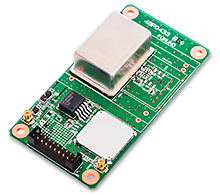Articles for ITS market CES organizer states "Data Period in 2020s." Transformation of the Automotive Industry in CES, US -CES2019 Report-
Toyota's Guardian (Advanced Safe Driving Assistance System) will convert to an Open Source
"The beginning of the year is CES."
In recent years this phrase has become synonymous with parties in the automotive industry.
In this series, over the past three years we have delivered a local report of the CES (Consumer Electronics Show).
This time I reported from CES 2019 (January 8-11, 2019, in Las Vegas, Nevada, U.S.A.). CES 2019 opened on Tuesday, January 8 in the morning, on Sunday, June 6 and Monday, July 7. Various presentations were made to the press at hotels in Las Vegas City.
Toyota attracted the most attention in the automotive sector. To date Toyota has advocated "Guardian" and "Chauffeur" as its approach to automated driving. The former is traveling while riding in the driver's seat and the latter promotes passengers freely moving around the vehicle in fully automated driving conditions.
The general interpretation of automated driving is that indicated by the SAE (Society of Automotive Engineers). Broadly speaking Toyota's "Guardians" seem to be at Level 3 and its "Chauffeur" is at Level 4 and above. At the press conference however, Dr. Gill Pratt who is the Toyota Executive Technical Advisor and president of the Toyota Research Institute claimed that the "SAE-level thinking and our thoughts are quite different.".
In addition Toyota decided to open-source the "Guardian" concept as an algorithm or software for installing on mass-produced vehicles.
In addition manufacturers that have been leading the world in the mass production of automated driving technologies such as Audi and Volvo have moved to modify the timing of the introduction of Level 3 social implementations. The reason for this is that current laws and regulations are not progressing and they actually do not match the current social situation.
Use case of automated driving using VR (virtual reality), such as rear seat riding
Under these circumstances this "use case" was emphasized at the CES exhibition by a leading Tier 1 automotive parts company. When automated driving is widely used in public it is necessary to clarify the specific applications in automated driving.
This sounds quite natural but in the automotive industry there are many cases in which technology progresses at different rates making it difficult to establish a so-called reference case strategy.
As a specific example, Valeo of France proposed a use case scenario for rear seat riding using VR (virtual reality). At a temporary facility outside the CES venue I was able to feel a simulation of being in the rear seat of a vehicle, actually traveling. For example, an elderly mother living alone in rural areas drives with their urban sons' family. Until now these ideas have existed as only a desktop theory. However when you wear special equipment and experience the video programs you feel part of a social atmosphere rather than just a simulation.
In addition NVIDIA, a major U.S. semiconductor company announced a mass-produced automated driving system with better than level 2 precision. The safety in automated driving was enhanced by monitoring the facial expression of the driver during driving, etc. only after obtaining Level 2 operation.
The 2020s are the "data period." Use data from the automobile industry will grow throughout society
 Google has an exhibition facility outside CES venue
Google has an exhibition facility outside CES venue
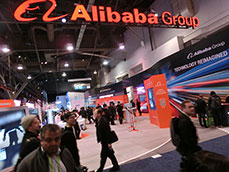 Alibaba, China exhibits voice recognition and e-commerce
Alibaba, China exhibits voice recognition and e-commerce
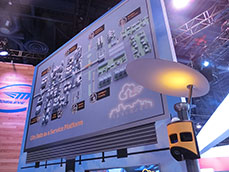 Continental, Germany exhibits equipment and systems that collect data throughout the town
Continental, Germany exhibits equipment and systems that collect data throughout the town
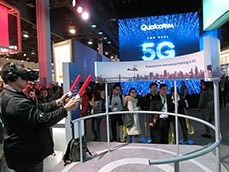 Qualcomm, a major semiconductors company is looking for a full-fledged introduction of 5G.
Qualcomm, a major semiconductors company is looking for a full-fledged introduction of 5G.
Now not only in the automotive field, but throughout CES 2019 as a whole, however sometimes it feels like a panoramic view.
It is the importance of data. The CES organizer explained that "We will move from the Connected Age of the 2010's to the Data Age in the 2020s."
This will lead to an increasing presence of Amazon, Google (parent company is Alphabet), Apple, and the Chinese IT companies, Baidu, Alibaba, and Tencent, who all have their own global cloud services. This time Google set up a large-scale exhibition facility outdoor and exhibited voice recognition technology while Alibaba also exhibited a connection between voice recognition technology and home entertainment.
Meanwhile semiconductor manufacturers are also attracting attention in the automotive-related data business. Of particular interest is Mobile Eye, Israeli who was acquired by Intel. The company designs semiconductors using its own image recognition technology and mass-produces them for car manufacturers such as GM, Ford, Nissan, and Mazda. The company is trying to expand new business areas simultaneously by analyzing various data obtained from car manufacturers.
In addition Continental from Germany installed equipment for data collection in the town to collect images, etc. and then devised construction of the data management system for the whole town including automobiles and public transportation. In the past automotive communications and data formats used names such as V2I, V2V, and V2X, but in the new data period of the 2020s automotive related data is likely to be used not only in the automotive industry but also in society as a whole.
Writer introduction

Mr. Kenji Momota Automotive journalist
His major is the world automotive industry and he is also familiar with the energy industry, IT and the aging society problem as the related fields. He acts around the world based in Japan and USA and writes for the general magazines, the technology journals and the automotive related media etc.
He is also commentator of motor race and world's motor show on TV program based on his career of the driver of Indy Racing League and NASCAR. In recent years, he has been covering about a paradigm shift from developed countries to developing countries, the motorized vehicle like EV and the telematics.
FURUNO ITS Journal
Click here for the latest articles after 2022 (in Japanese)2022
- The "realistic" self-driving roadmap shown by the Japanese government and a hands-on report on the latest Subaru EyeSight X
- Will FCVs (Fuel Cell Vehicles) Become Popular? ~New Movement in Toyota and Honda~
- The 'Complete' online sales of new cars start in Japan. Will this new way of buying cars take root?
- Many Firsts! On-Site Report from Tokyo Auto Salon 2022 - The author, who knows what goes on behind the scenes, looks back on 40 years of history. -
2021
- "Moving toward zero traffic fatalities for four-wheeled and two-wheeled vehicles globally in 2050" ~Experience on Honda's latest safety technologies~
- Tsuneishi Shipbuilding's building and DX, an exclusive visit to the main factory
- Japan's Smart City: New Moves toward Practical Use
- When will self-driving buses (service cars) be put to "full-scale" practical use?
- Utilization vehicle data during disasters
- Toyota-led Connected Technology to Transform Commercial Vehicle Business -From light trucks to large trucks and buses-
- Toyota enters the connected car "Personalization" business
- Japanese automakers' carbon-neutral strategies swept up in ESG investment
- Drive experience of the latest autonomous vehicle models and advanced driving support systems
- Will carbon neutrality accelerate the trend to strengthen LCA (Life Cycle Assessment)?
- Semiconductor shortage exposes realities of the automotive industry
- Online Autonomous Driving Contest Enhancing development of Human Resources
2020
- What happens to CASE when gas cars are banned in Japan?
- When will Flying Cars be launched?
- Expectation vs. reality:Autonomous Driving in Japan
- V2X, Becoming increasingly important in autonomous driving
- Technology of Subaru “EyeSight X”
- Lifestyle-oriented French cars gain popularity in Japan
- Human-oriented smart cities are wanted
- MaaS and CASE, how would automotive industry change after COVID-19?
- The beginning of virtualization era, triggered by COVID-19
- Trend of EV shift and consumer demands
- TOYOTA Press conference about ADAS - Releasing algorithm for "sudden acceleration suppression during attempted sudden acceleration" free of charge -
- The Japanese automotive industry in 2020 - 3 turning points -
- "Using a smartphone while driving" and "Level 3 automated driving"
2019
- Motor show business model is at a turning point - Tokyo Motor Show Report -
- Commercialization and monetization of MaaS - ITS World Congress Singapore Report -
- Android Automotive pays attention to V2X - Report from the Frankfurt Motor Show 2019 in Germany -
- Automobile Distribution Revolution and DCM (Data Communication Module)
- Connected business potential and newly proposed "eMaaS" by Honda
- 5G services for practical use are multiplying
- Connectivity technologies attracting attention due to frequent traffic accidents
- Shanghai Motor Show report -SUV, EV, Automated car & 5G-
- Drone Business roadmap and updates to Michibiki (Quasi-Zenith Satellite System)
- MaaS (Mobility as a Service) "town development." Full-scale promotion for a national project
- CES organizer states "Data Period in 2020s." Transformation of the Automotive Industry in CES, US "-CES2019 Report-"
- "Return to Origin" directed towards the age of change, automatic operation and connectivity
2018
- New proposal for Private Car Automated Driving Level and other Hot 5G Technology Topics
- Standardized EV charging infrastructure concerns in Europe, US, Japan and China - Kobe EVS 31 field report -
- Touring a pure car carrier and a test drive of the latest hybrid car
- Planning stage products are exhibited at the newly established visualized mobility service "TOYOTA MOBILITY SHOWROOM".
- Potential “Community Car-share” program promoted by local residents
- CES Asia Report 2108
- Companies attempt new Vehicle-to-Infrastructure communications, including traffic volume measurements and vehicle positioning. -ITS Asia Pacific Forum in Fukuoka-
- Geneva show in Switzerland. Flying cars and MaaS (Mobility as a Service) were hot topics.
- EV (Electric Vehicle) proposals by country
- MaaS competition through service mobilization, M & A and technical field collaboration is accelerating. - The CES 2018 Report -
2017
- Big data’s initiative and fight for the automotive industry. Cooperation among companies becomes increasingly important.
- Connected car and road-to-vehicle communication automatic operation
- ETC (Electronic Toll Collection) and ETC2.0. Current situation and projected future
- Rapid development of sharing economy
- Germany is first to recognize level 3 automated driving
- ITS EU 2017 Field Reports -Automatic Operation and the eCall-
- From Infotainment to ITS, the competitive area is spreading in the car big data industry.
- GTC (GPU Technology Conference) Report and the de facto standardization of AI (artificial intelligence)
- Renesas' new challenge! "e-AI Solution" and "Renesas Autonomy"
- The Automobile industry is shifting from a manufacturing industry to a service industry.
- The movement toward accident countermeasures for aging drivers in Japan
- Fusion of ride sharing and fully automated driving is advancing in the USA.
2016
- Overview of the Quasi-Zenith Satellite System (QZSS) and advancements toward full-scale practical use including the Tokyo Olympic Games - G-space EXPO 2016 report-
- Japan’s automated driving project "SIP-adus" will be a large demonstration experiment.
- The International Home Care & Rehabilitation Exhibition. There were many car manufactures with exhibits booths at this show.
- Japanese car manufacturers starting to concentrate on strengthening the ADAS system
- A new movement of legislation for autonomous cars
- Cyber Security and “AGL”, the new OS for automotive are hot topics in the connected car industry
- “High precision 3D map” the key future of autonomous car and pedestrian dead reckoning
- Chinese “BAT” is accelerating their business in the EV (Electric Vehicle) market
- Tesla's original connection to Taiwan and the new transportation system technologies.
- "The main topic" of the Geneva Motor Show was how to strengthen "pedestrian protection"
- The probe data business is getting more competitive
- Reporting directly from the 2016 CES show "Data services will soon become the main revenue source of automotive industry"
2015
- Do the automated driving systems need the GNSS (Global Navigation Satellite System) ?
- ETC Version 2.0 is coming soon. A new service was announced at the Tokyo Motor Show and the possibility that is could be used as a device for older drivers.
- "Connected Horizon" and "eHorizon". Germany's leading parts supplier accelerates strengthening of "Big Data" for business



 CES 2019 venue in Las Vegas, U.S.A.
CES 2019 venue in Las Vegas, U.S.A. Open-source "Guardian" that Toyota claims
Open-source "Guardian" that Toyota claims Valeo, France exhibits VR-based use cases.
Valeo, France exhibits VR-based use cases. NVIDIA’s high-level 2 using driver monitoring while driving
NVIDIA’s high-level 2 using driver monitoring while driving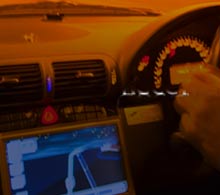 GPS/GNSS Receiver&Chips and Modules (positioning and timing)
GPS/GNSS Receiver&Chips and Modules (positioning and timing)